Geochemical Evidence of Organic Matter Enrichment and Depositional Dynamics in the Lower Cambrian Yurtus Formation, NW Tarim Basin: Insights into Hydrothermal Influence and Paleoproductivity Mechanisms
Abstract
1. Introduction
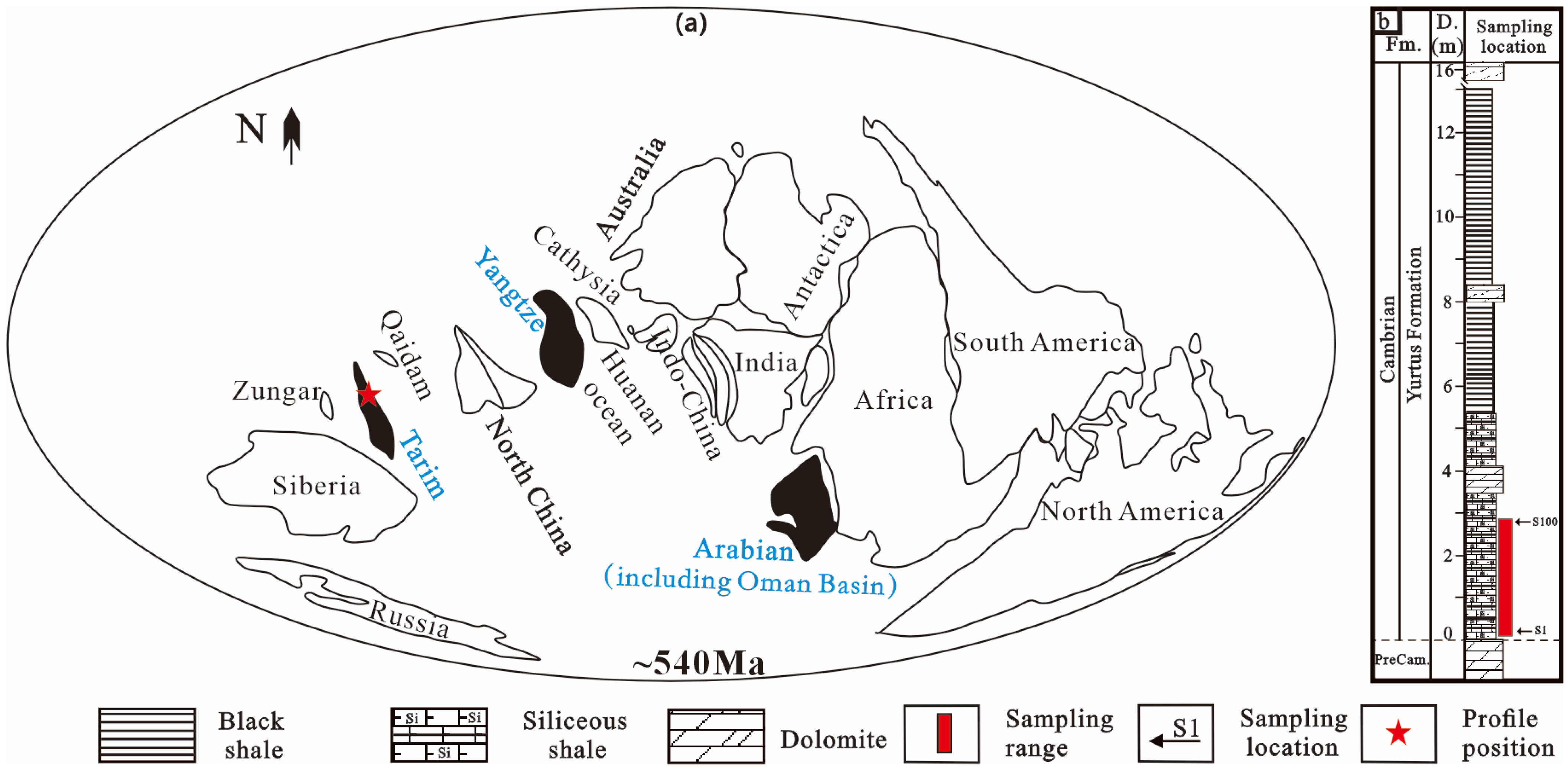
2. Geological Setting
3. Materials and Methods
4. Results
4.1. Major Elements
4.2. Trace Elements
4.3. REEs
4.4. Biomarkers
5. Discussion
5.1. Role of Terrigenous Influx
5.2. Paleoproductivity
5.3. Sedimentary Environment
5.4. Hydrothermal Activity
5.5. Organic Matter Enrichment Mechanism
5.6. Depositional Model
6. Conclusions
- (1)
- The Є1y Formation exhibits notable geochemical signatures, including elevated concentrations of Mo, Ba, and U, and a ΣREE of 155.75 μg/g, with a strong enrichment of light rare earth elements (LREE/HREE = 1.74–5.57), moderate Ce negative anomaly (δCe = 0.4–0.71), and a significant Eu positive anomaly (δEu = 0.94–2.14), indicating a unique depositional environment influenced by hydrothermal processes;
- (2)
- Geochemical parameters, including trace element and rare earth element distributions, point to the deposition of the Є1y black shales in a highly reducing, anoxic, and sulfide-rich environment, which was conducive to organic matter preservation and enhanced sedimentary productivity;
- (3)
- The presence of hydrothermal trace elements, introduced via hydrothermal fluids, suggests a critical role in enriching the sedimentary system, preserving organic matter, and boosting the overall paleoproductivity in the shallow marine environment of the Tarim Basin during the Early Cambrian;
- (4)
- Hydrothermal fluids, likely emanating from volcanic activities along fractures and faults during the Early Cambrian, were instrumental in enhancing marine primary productivity, fostering the accumulation of organic matter, and contributing to the formation of high-quality source rocks in the Є1y Formation. The organic matter enrichment model has been established;
- (5)
- The integrated geochemical findings suggest that the Early Cambrian period in the Tarim Basin experienced a dynamic interplay between hydrothermal influences and organic productivity, laying the foundation for significant oil and gas reserves in the deep and ultra-deep strata of the basin.
Author Contributions
Funding
Data Availability Statement
Conflicts of Interest
References
- Goldberg, T.; Poulton, S.W.; Strauss, H. Sulphur and oxygen isotope signatures of late Neoproterozoic to early Cambrian sulphate, Yangtze Platform, China: Diagenetic constraints and seawater evolution. Precambrian Res. 2005, 137, 223–241. [Google Scholar] [CrossRef]
- Wang, J.; Chen, D.; Yan, D.; Wei, H.; Xiang, L. Evolution from an anoxic to oxic deep ocean during the Ediacaran–Cambrian transition and implications for bioradiation. Chem. Geol. 2012, 306–307, 129–138. [Google Scholar] [CrossRef]
- Fike, D.A.; Grotzinger, J.P.; Pratt, L.M.; Summons, R.E. Multi-stage Ediacaran ocean oxidation and its impact on evolutionary radiation. Geochim. Cosmochim. Acta 2006, 70, A173. [Google Scholar] [CrossRef]
- Chen, J.; Xu, J.; Wang, J.; Liu, P.; Chen, F.; Li, M. Paleo-environmental variation and its control on organic matter enrichment in the black rock series, Cambrian Yuertusi Formation in the northwestern Tarim Basin. Earth Sci. Front. 2023, 30, 150–161, (In Chinese with English abstract). [Google Scholar]
- Zhu, G.; Chen, F.; Chen, Z.; Zhang, Y.; Xing, X.; Tao, X.; Ma, D. Discovery and basic characteristics of high-quality source rocks found in the Yuertusi Formation of the Cambrian in Tarim Basin, China. J. Nat. Gas Geosci. 2016, 1, 21–33. [Google Scholar] [CrossRef]
- Zhu, G.; Zhang, Z.; Zhou, X.; Li, T.; Han, J.; Sun, C. The complexity, secondary geochemical process, genetic mechanism and distribution prediction of deep marine oil and gas in the Tarim Basin, China. Earth Sci. Rev. 2019, 198, 102930. [Google Scholar] [CrossRef]
- Zhang, C.; Guan, S.; Wu, L.; Ren, R.; Wang, L.; Wu, X. Depositional environments of early Cambrian marine shale, northwestern Tarim Basin, China: Implications for organic matter accumulation. J. Petrol. Sci. Eng. 2020, 194, 107497. [Google Scholar] [CrossRef]
- Li, W.; Wang, J.; Jia, C.; Lu, S.; Li, J.; Zhang, P.; Wei, Y.; Song, Z.; Chen, G.; Zhou, N. Carbon isotope fractionation during methane transport through tight sedimentary rocks: Phenomena, mechanisms, characterization, and implications. Geosci. Front. 2024, 15, 101912. [Google Scholar] [CrossRef]
- Wang, X.; Zhang, S.; He, K.; Wang, H.; Mi, J.; Su, J.; Ye, Y. OMZ and euxinic sulfidic environments dominating hydrocarbon generation poential of organic matter1.4 billion years ago. Chin. Sci. Bull. 2021, 66, 3005–3017. [Google Scholar] [CrossRef]
- He, T.; Li, W.; Lu, S.; Pan, W.; Ying, J.; Zhu, P.; Yang, E.; Wang, X.; Zhang, B.; Sun, D. Mechanism and geological significance of anomalous negative δ13Ckerogen in the Lower Cambrian, NW Tarim Basin, China. J. Petrol. Sci. Eng. 2022, 208, 109384. [Google Scholar] [CrossRef]
- Li, Y.; Xiong, Y.; Liang, Q.; Fang, C.; Chen, Y.; Wang, X.; Liao, Z.; Peng, P.A. The application of diamondoid indices in the Tarim oils. AAPG Bull. 2018, 102, 267–291. [Google Scholar] [CrossRef]
- Tribovillard, N.; Algeo, T.; Lyons, T.; Riboulleau, A. Trace metals as paleoredox and paleoproductivity proxies: An update. Chem. Geol. 2006, 232, 12–32. [Google Scholar] [CrossRef]
- Mansour, A.; Wagreich, M.; Gentzis, T.; Ocubalidet, S.; Tahoun, S.; Elewa, A. Depositional and organic carbon-controlled regimes during the Coniacian-Santonian event: First results from the southern Tethys (Egypt). Mar. Petrol. Geol. 2020, 115, 104285. [Google Scholar] [CrossRef]
- Mansour, A.; Wagreich, M. Earth system changes during the cooling greenhouse phase of the Late Cretaceous: Coniacian-Santonian OAE3 subevents and fundamental variations in organic carbon deposition. Earth-Sci. Rev. 2022, 229, 104022. [Google Scholar] [CrossRef]
- Tyson, R. Sedimentation rate, dilution, preservation and total organic carbon: Some results of a modelling study. Org. Geochem. 2001, 32, 333–339. [Google Scholar] [CrossRef]
- Liu, J.; Liu, Q.; Zhu, D.; Meng, Q.; Liu, W.; Qiu, D.; Huang, Z. The role of deep fluid in the formation of organic-rich source rocks. J. Nat. Gas Geosci. 2018, 3, 171–180. [Google Scholar] [CrossRef]
- Zhang, B.; Zhang, S.; Bian, L.; Jin, Z.; Wang, D. Developmental modes of the Neoproterozoic-Lower Paleozoic marine hydrocarbon source rocks in China. Chin. Sci. Bull. 2007, 52, 77–91. [Google Scholar] [CrossRef]
- Gao, Z.; Shi, J.; Lv, J.; Chang, Z. High-frequency sequences, geochemical characteristics, formations, and distribution predictions of the lower Cambrian Yuertusi Formation in the Tarim Basin. Mar. Petrol. Geol. 2022, 146, 105966. [Google Scholar] [CrossRef]
- Zhou, L.; Algeo, T.J.; Shen, J.; Hu, Z.; Gong, H.; Xie, S.; Huang, J.; Gao, S. Changes in marine productivity and redox conditions during the Late Ordovician Hirnantian glaciation. Palaeogeogr. Palaeoclimatol. Palaeoecol. 2015, 420, 223–234. [Google Scholar] [CrossRef]
- Zhou, X.; Chen, D.; Dong, S.; Zhang, Y.; Guo, Z.; Wei, H.; Yu, H. Diagenetic barite deposits in the Yurtus Formation in Tarim Basin, NW China: Implications for barium and sulfur cycling in the earliest Cambrian. Precambrian Res. 2015, 263, 79–87. [Google Scholar] [CrossRef]
- Zhang, S.; Wang, X.; Hammarlund, E.; Wang, H.; Costa, M.; Bjerrum, C.; Connelly, J.; Zhang, B.; Bian, L.; Canfield, D.E. Orbital forcing of climate 1.4 billion years ago. Proc. Natl. Acad. Sci. USA 2015, 112, E1406–E1413. [Google Scholar] [CrossRef] [PubMed]
- Wang, X.; Zhao, W.; Zhang, S.; Wang, H.; Su, J.; Canfield, D.E.; Hammarlund, E.U. The aerobic diagenesis of Mesoproterozoic organic matter. Sci. Rep. 2018, 8, 13324. [Google Scholar] [CrossRef] [PubMed]
- Taylor, S.R.; McClennan, S.M. The Continental Crust: Its Composition and Evolution; Blackwell Scientific Publications: Oxford, UK, 1985; Volume 21, p. 312. [Google Scholar]
- He, T.; Lu, S.; Li, W.; Sun, D.; Pan, W.; Zhang, B.; Tan, Z.; Ying, J. Paleoweathering, hydrothermal activity and organic matter enrichment during the formation of earliest Cambrian black strata in the northwest Tarim Basin, China. J. Petrol. Sci. Eng. 2020, 189, 106987. [Google Scholar] [CrossRef]
- Xu, L.; Lehmann, B.; Zhang, X.; Zheng, W.; Meng, Q. Trace element distribution in black shales from the Kunyang phosphorite deposit and its geological significances. Acta Petrol. Sin. 2014, 30, 1817–1827, (In Chinese with English abstract). [Google Scholar]
- Goldberg, E.D.; Arrhenius, G. Chemistry of Pacific pelagic sediments. Geochim. Cosmochim. Act. 1958, 13, 153–212. [Google Scholar] [CrossRef]
- Zhou, X.; Chen, D.; Qing, H.; Qian, Y.; Wang, D. Submarine silica-rich hydrothermal activity during the earliest Cambrian in the Tarim Basin, northwest China. Int. Geol. Rev. 2014, 56, 1906–1918. [Google Scholar] [CrossRef]
- Li, W.; Lu, S.; Tan, Z.; He, T. Lacustrine Source Rock Deposition in Response to Coevolution of the Paleoenvironment and Formation Mechanism of Organic-Rich Shales in the Biyang Depression, Nanxiang Basin. Energy Fuels 2017, 31, 13519–13527. [Google Scholar] [CrossRef]
- Rahman, S.; Henderson, G.M.; Rickaby, R.E.M. Biogenic barium as a productivity proxy in the South Pacific Ocean. Paleoceanogr. Paleoclimatol. 2022, 37, e2021PA004291. [Google Scholar]
- Zhu, G.; Wang, P.; Li, T.; Zhao, K.; Yan, H.; Li, J.; Zhou, L. Nitrogen geochemistry and abnormal mercury enrichment of shales from the lowermost Cambrian Niutitang Formation in South China: Implications for the marine redox conditions and hydrothermal activity. Global Planet. Change 2021, 199, 103449. [Google Scholar] [CrossRef]
- Moghaddam, M.; Hadavi, F. Changes in productivity in the boundary between Abderaz and Abtalkh Formations (East Kopet Dagh, NE Iran) evidenced by calcareous nannofossils and elements (Zn, Cu, Cd, Pb and CaCO3). Arab. J. Geosci. 2014, 7, 5309–5320. [Google Scholar] [CrossRef]
- Algeo, T.J.; Maynard, J.B. Trace-element behavior and redox facies in core shales of Upper Pennsylvanian Kansas-type cyclothems. Chem. Geol. 2004, 206, 289–318. [Google Scholar] [CrossRef]
- Algeo, T.J.; Hinnov, L.; Moser, J.; Maynard, J.B.; Elswick, E.; Kuwahara, K.; Sano, H. Changes in productivity and redox conditions in the Panthalassic Ocean during the latest Permian. Geology 2010, 38, 187–190. [Google Scholar] [CrossRef]
- He, T.; Zeng, Q.; Lu, S.; Li, W.; Li, M.; Wen, Z.; Yang, E.; Jing, T.; Ying, J.; Zhu, P.; et al. Aryl isoprenoids from the Lower Paleozoic in the Tarim Basin, NW China: Insight into deep ancient hydrocarbon exploration. Geoenergy Sci. Eng. 2023, 225, 211666. [Google Scholar] [CrossRef]
- He, T.; Li, W.; Lu, S.; Yang, E.; Jing, T.; Ying, J.; Zhu, P.; Wang, X.; Pan, W.; Chen, Z. Distribution and isotopic signature of 2-alkyl-1,3,4-trimethylbenzenes in the Lower Paleozoic source rocks and oils of Tarim Basin: Implications for the oil-source correlation. Petrol. Sci. 2022, 19, 2572–2582. [Google Scholar] [CrossRef]
- Connock, G.T.; Nguyen, T.X.; Philip, R.P. The development and extent of photic-zone euxinia concomitant with Woodford Shale deposition. AAPG Bull. 2018, 102, 959–986. [Google Scholar] [CrossRef]
- Hays, L.; Beatty, T.; Henderson, C.; Love, G.; Summons, R. Evidence for photic zone euxinia through the end-Permian mass extinction in the Panthalassic Ocean (Peace River Basin, Western Canada). Palaeoworld 2007, 16, 39–50. [Google Scholar] [CrossRef]
- Schwark, L.; Frimmel, A. Chemostratigraphy of the Posidonia Black Shale, SW-Germany: II. Assessment of extent and persistence of photic-zone anoxia using aryl isoprenoid distributions. Chem. Geol. 2004, 206, 231–248. [Google Scholar] [CrossRef]
- Xu, J.; He, T.; Zeng, Q.; Zhao, Y.; Wen, Z. Compound-Specific C/H Isotopic Signature of Ultra-Deep Hydrocarbon Fluids from the Shuntuoguole Area in the Tarim Basin, Northwestern China. Energies 2024, 17, 1211. [Google Scholar] [CrossRef]
- He, T.; Li, W.; Lu, S.; Yang, E.; Jing, T.; Ying, J.; Zhu, P.; Wang, X.; Pan, W.; Zhang, B.; et al. Quantitatively unmixing method for complex mixed oil based on its fractions carbon isotopes: A case from the Tarim Basin, NW China. Petrol. Sci. 2023, 20, 102–113. [Google Scholar] [CrossRef]
- Sun, Y.; Xu, S.; Lu, H.; Cuai, P. Source facies of the Paleozoic petroleum systems in the Tabei uplift, Tarim Basin, NW China: Implications from aryl isoprenoids in crude oils. Org. Geochem. 2003, 34, 629–634. [Google Scholar] [CrossRef]
- Zhu, G.; Milkov, A.V.; Li, J.; Xue, N.; Chen, Y.; Hu, J.; Li, T.; Zhang, Z.; Chen, Z. Deepest oil in Asia: Characteristics of petroleum system in the Tarim basin, China. J. Petrol. Sci. Eng. 2021, 199, 108246. [Google Scholar] [CrossRef]
- Zhao, K.; Zhu, G.; Meng, X.; Yan, H.; Li, T.; Wang, P. Enrichment of mercury in the Lower Cambrian sedimentary successions by submarine hydrothermal venting. J. Asian Earth Sci. 2022, 240, 105439. [Google Scholar] [CrossRef]
- Sweere, T.; van den Boorn, S.; Dickson, A.J.; Reichart, G.-J. Definition of new trace-metal proxies for the controls on organic matter enrichment in marine sediments based on Mn, Co, Mo and Cd concentrations. Chem. Geol. 2016, 441, 235–245. [Google Scholar] [CrossRef]
- Jin, Z.; Yang, L.; Zeng, J.; Zhang, L. Deep fluid activitities and their effects on generation of hydrocarbon in Dongying depression. Pet. Explor. Dev. 2002, 2, 42–44. [Google Scholar]


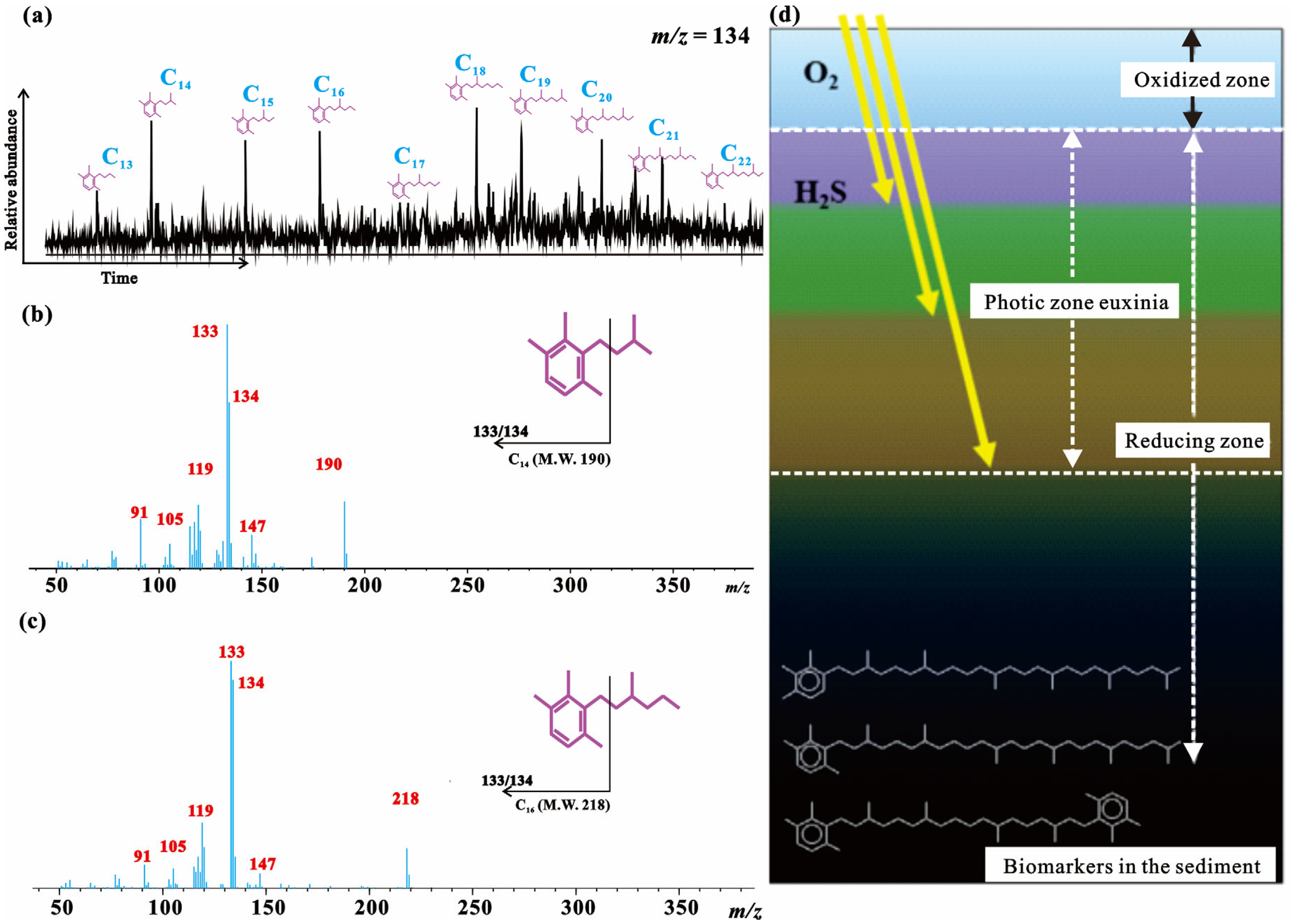
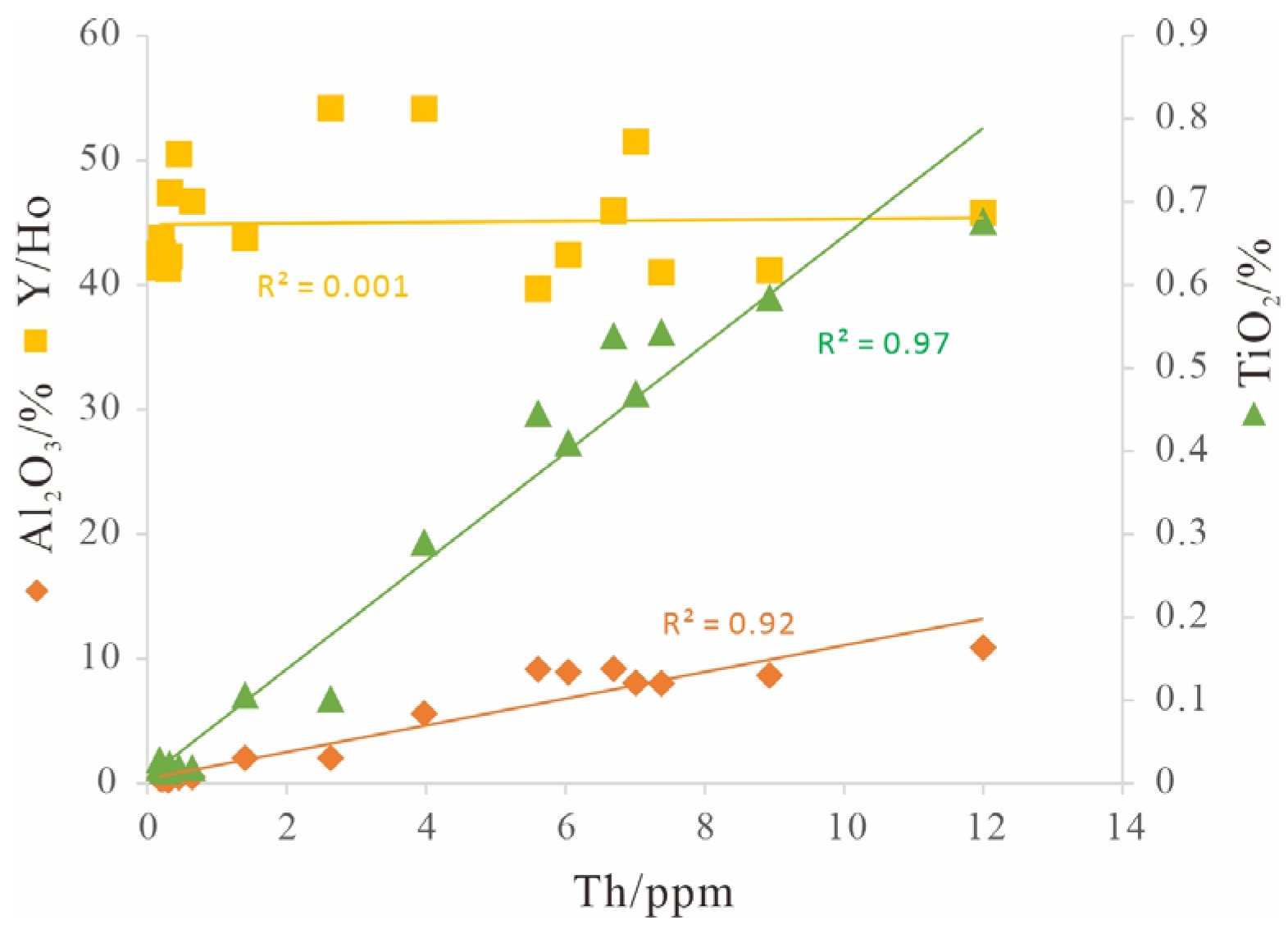
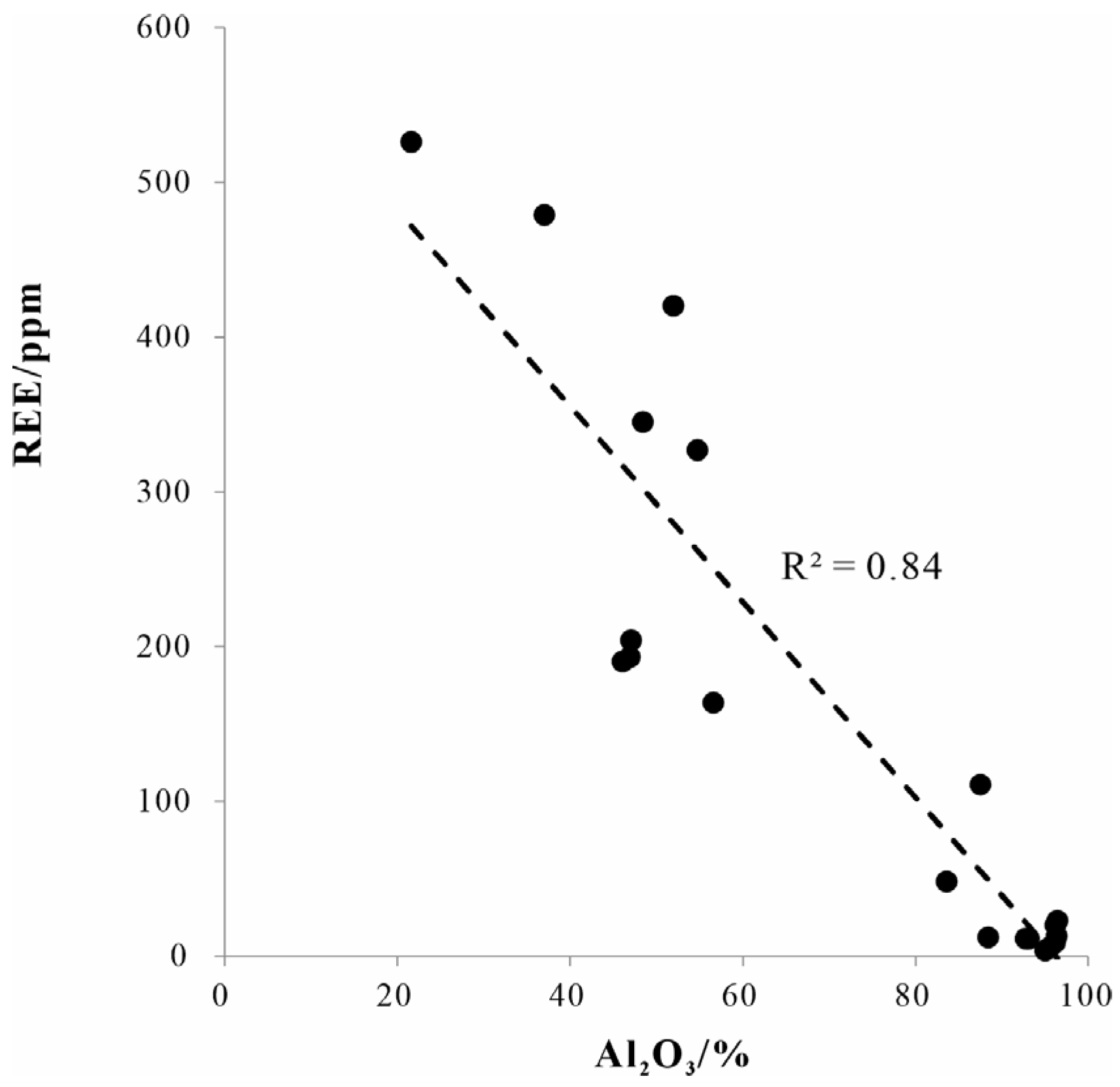
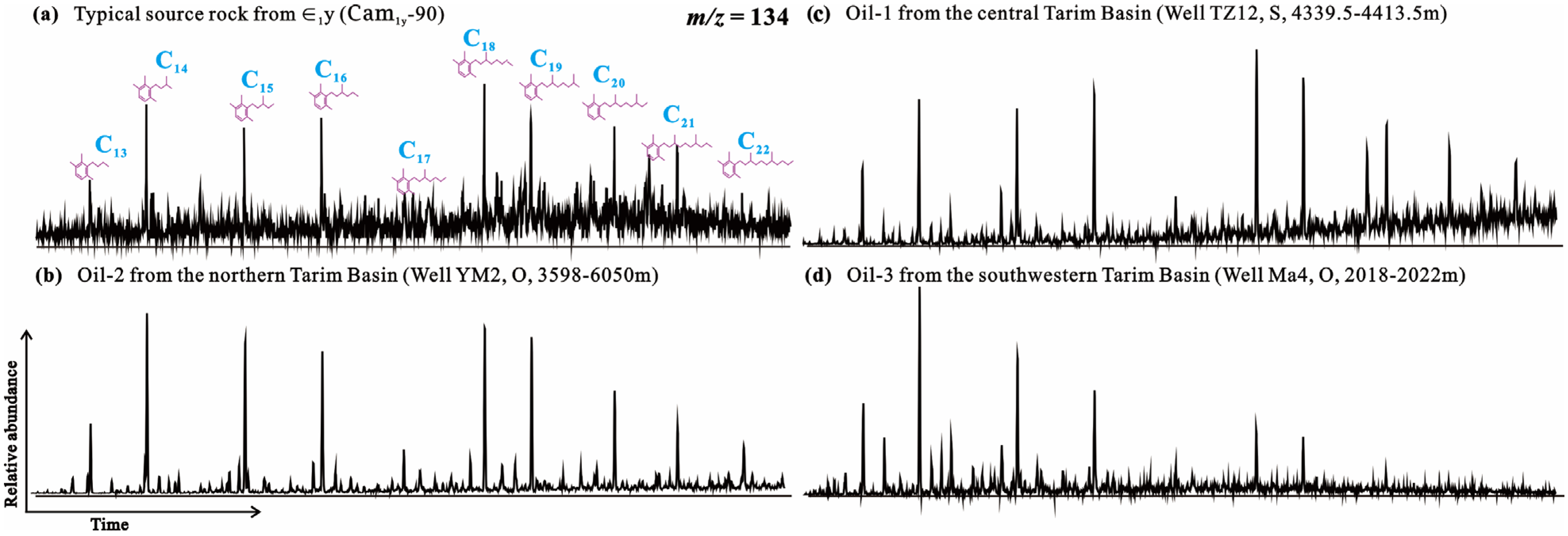


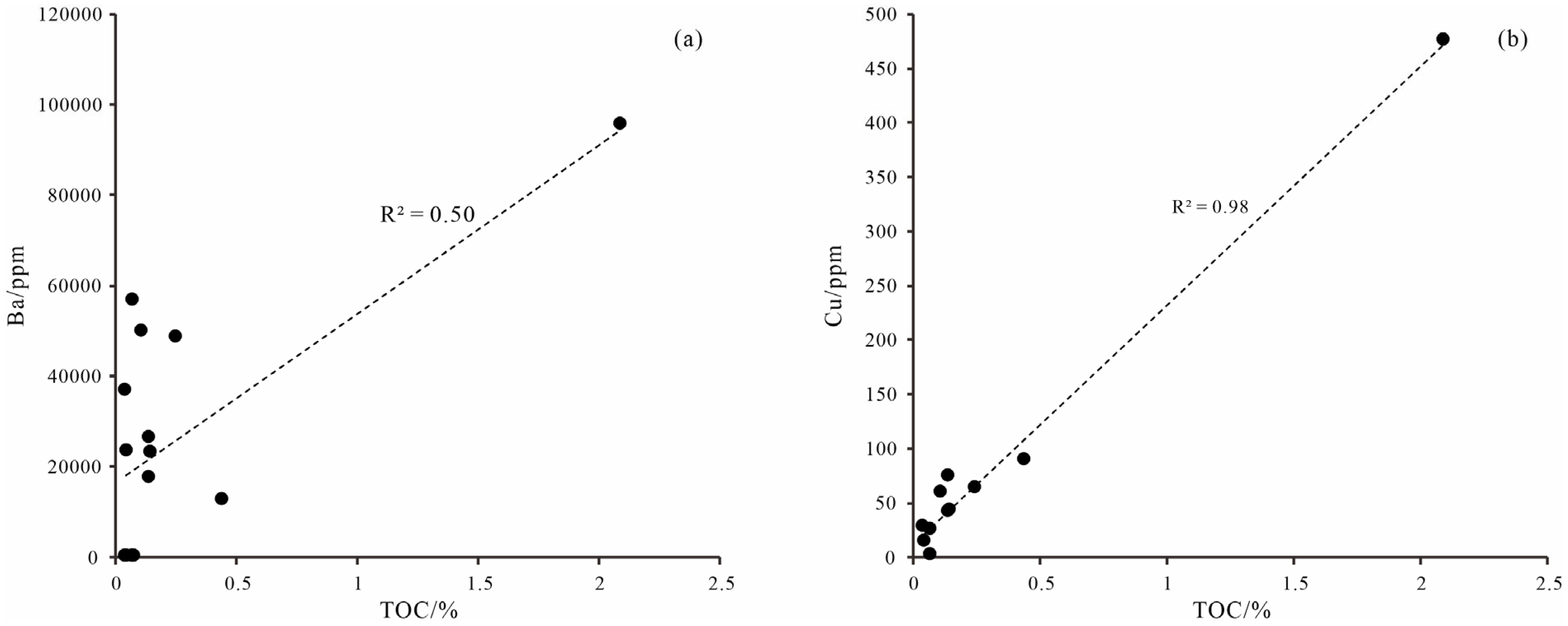
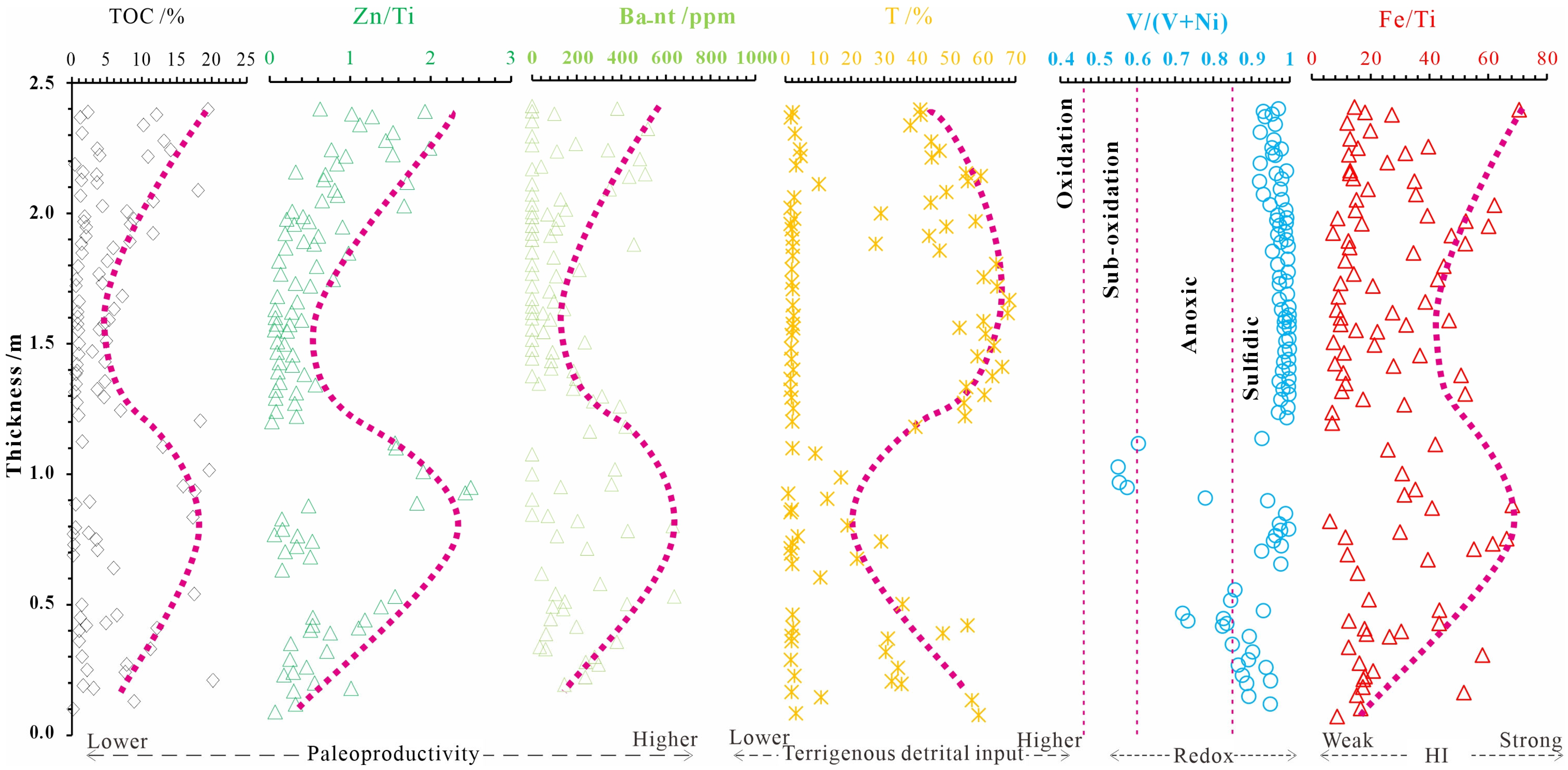
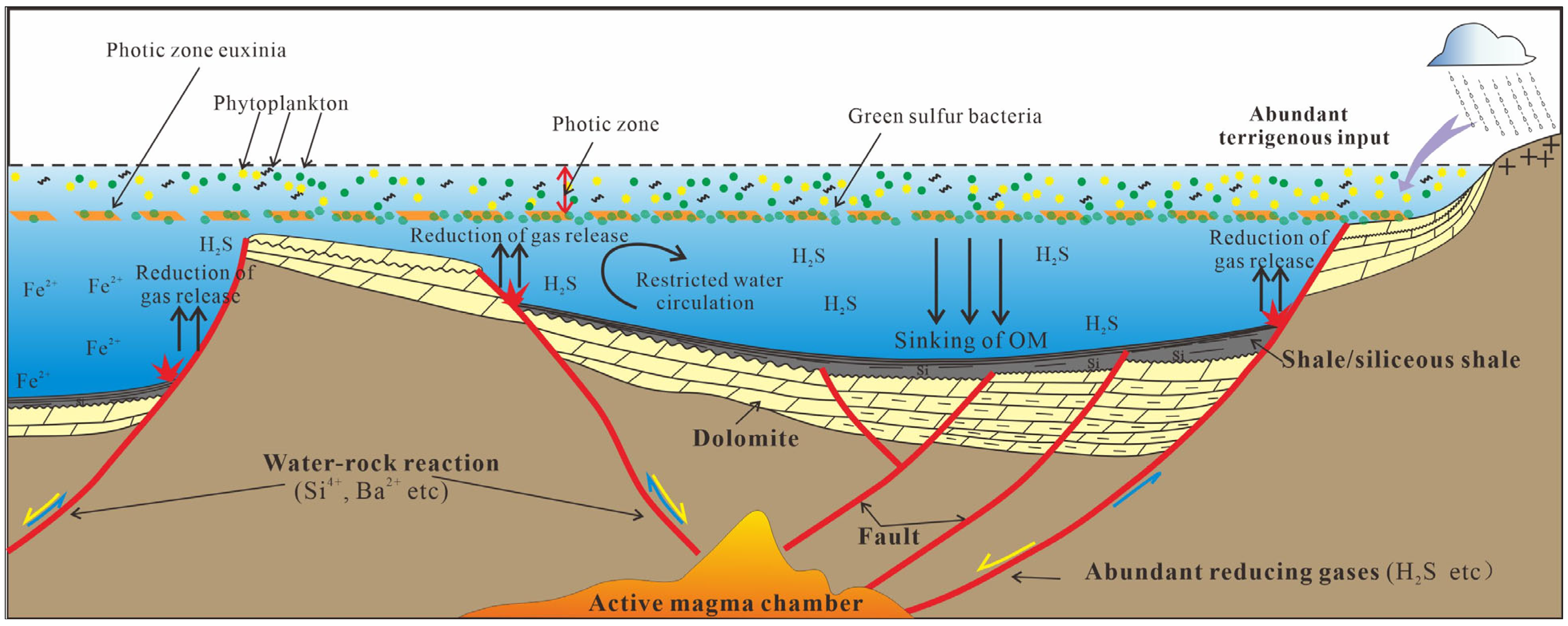
| Number | Interval | Horizon | Lithology | SiO2 /% | Al2O3 /% | Fe2O3 /% | MgO /% | CaO /% | MnO /% | TiO2 /% | P2O5 /% | LOI /% | FeO /% | TOC /% |
|---|---|---|---|---|---|---|---|---|---|---|---|---|---|---|
| Cam1y-5 | 0.21 | Є1y | Siliceous shale | 93.09 | 0.539 | 0.146 | 0.426 | 1.21 | - | 0.018 | 0.451 | 3.87 | 0.11 | 20.18 |
| Cam1y-10 | 0.33 | Є1y | Siliceous shale | 95.56 | 0.387 | 0.408 | 0.131 | 0.177 | - | 0.016 | 0.019 | 3.08 | 0.35 | 11.25 |
| Cam1y-15 | 0.43 | Є1y | Siliceous rock | 54.72 | 9.19 | 7.46 | 1.37 | 2.06 | 0.005 | 0.538 | 1.03 | 15.24 | 0.72 | 4.87 |
| Cam1y-20 | 0.64 | Є1y | Siliceous shale | 83.61 | 2.04 | 0.758 | 0.358 | 0.452 | - | 0.106 | 0.208 | 10.71 | 0.59 | 5.96 |
| Cam1y-25 | 0.77 | Є1y | Siliceous rock | 96.13 | 0.426 | 0.618 | 0.115 | 0.328 | - | 0.021 | 0.173 | 1.82 | 0.52 | 0.2 |
| Cam1y-30 | 0.895 | Є1y | Siliceous shale | 88.38 | 0.449 | 0.568 | 0.993 | 2.01 | 0.006 | 0.019 | 0.068 | 6.6 | 0.49 | 2.54 |
| Cam1y-35 | 1.125 | Є1y | Siliceous rock | 92.72 | 0.399 | 0.501 | 0.069 | 0.752 | - | 0.021 | 0.029 | 4.76 | 0.43 | 1.49 |
| Cam1y-40 | 1.295 | Є1y | Siliceous shale | 48.41 | 8.04 | 6.31 | 1.6 | 1.26 | - | 0.543 | 1.1 | 22.25 | 1.63 | 4.6 |
| Cam1y-45 | 1.385 | Є1y | Siliceous rock | 96.32 | 0.261 | 0.412 | 0.066 | 0.112 | - | 0.015 | 0.065 | 2.04 | 0.36 | 0.58 |
| Cam1y-50 | 1.47 | Є1y | Siliceous shale | 37.01 | 8.67 | 4.43 | 1.71 | 5.6 | 0.004 | 0.584 | 2.09 | 25.03 | 0.95 | 2.93 |
| Cam1y-55 | 1.575 | Є1y | Siliceous rock | 96.16 | 0.462 | 0.322 | 0.087 | 0.126 | - | 0.023 | 0.064 | 2.4 | 0.28 | 0.85 |
| Cam1y-60 | 1.632 | Є1y | Siliceous shale | 51.95 | 10.91 | 3.58 | 1.6 | 0.662 | - | 0.676 | 1.5 | 18.85 | 1.21 | 6.04 |
| Cam1y-65 | 1.747 | Є1y | Siliceous rock | 96.42 | 0.375 | 0.365 | 0.064 | 0.193 | - | 0.019 | 0.066 | 2.26 | 0.3 | 0.64 |
| Cam1y-70 | 1.867 | Є1y | Siliceous shale | 47.03 | 8.07 | 4.8 | 1.67 | 1.68 | 0.004 | 0.469 | 1.94 | 21.6 | 0.34 | 5.92 |
| Cam1y-75 | 1.947 | Є1y | Siliceous rock | 87.51 | 0.505 | 0.514 | 0.074 | 2.88 | - | 0.019 | 1.71 | 5.99 | 0.42 | 2.05 |
| Cam1y-80 | 2.007 | Є1y | Siliceous shale | 56.55 | 5.59 | 2.78 | 0.961 | 3.95 | - | 0.29 | 2.64 | 20.79 | 0.82 | 7.88 |
| Cam1y-85 | 2.117 | Є1y | Siliceous rock | 21.61 | 2.03 | 1.58 | 0.288 | 31.92 | - | 0.101 | 23.44 | 9.56 | 1.3 | 3.6 |
| Cam1y-90 | 2.217 | Є1y | Siliceous shale | 46.93 | 9.17 | 3.92 | 1.75 | 2.99 | 0.007 | 0.445 | 1.79 | 23.43 | 0.8 | 10.88 |
| Cam1y-95 | 2.307 | Є1y | Siliceous rock | 95.01 | 0.438 | 0.247 | 0.248 | 0.379 | - | 0.028 | 0.02 | 3.31 | 0.21 | 1.46 |
| Cam1y-100 | 2.397 | Є1y | Siliceous shale | 46.04 | 8.95 | 3.36 | 1.9 | 3.1 | 0.006 | 0.41 | 1.61 | 26.51 | 1.58 | 14.04 |
| Number | Mo /ppm | Ba /ppm | U /ppm | Ba/Sr | V/(V + Ni) | Th/U | U/Th | Zn/Ti | Ni/Co | Rb/K | Th/Sc | Y/Ho | Cd/Mo |
|---|---|---|---|---|---|---|---|---|---|---|---|---|---|
| Cam1y-5 | 2.29 | 300 | 10.1 | 3.75 | 0.88 | 0.06 | 15.68 | 0.55 | 5.67 | 30.80 | 3.32 | 46.70 | 1.19 |
| Cam1y-10 | 7 | 216 | 4.11 | 4.33 | 0.85 | 0.05 | 18.77 | 0.71 | 5.96 | 35.26 | 0.98 | 42.60 | 0.26 |
| Cam1y-15 | 283 | 730 | 113 | 2.87 | 0.83 | 0.06 | 16.89 | 0.53 | 17.39 | 11.97 | 0.64 | 45.97 | 0.08 |
| Cam1y-20 | 9.92 | 362 | 23 | 3.38 | 0.98 | 0.06 | 16.43 | 0.15 | 25.70 | 16.76 | 0.74 | 43.77 | 0.37 |
| Cam1y-25 | 7.98 | 93.8 | 6.75 | 3.57 | 0.98 | 0.03 | 33.92 | 0.34 | 13.90 | 19.93 | 0.78 | 43.81 | 0.11 |
| Cam1y-30 | 15.9 | 377 | 12.8 | 6.78 | 0.78 | 0.01 | 72.73 | 1.82 | 11.55 | 13.56 | 0.83 | 42.50 | 0.36 |
| Cam1y-35 | 15.4 | 441 | 14.5 | 7.16 | 0.93 | 0.01 | 73.98 | 1.55 | 12.79 | 14.67 | 0.51 | 41.89 | 0.21 |
| Cam1y-40 | 176 | 619 | 187 | 2.36 | 1.00 | 0.04 | 25.34 | 0.07 | 21.23 | 20.39 | 0.74 | 41.02 | 0.07 |
| Cam1y-45 | 14.9 | 102 | 9.42 | 6.46 | 0.98 | 0.03 | 31.82 | 0.42 | 11.20 | 28.35 | 0.81 | 41.30 | 0.10 |
| Cam1y-50 | 144 | 308 | 121 | 1.49 | 1.00 | 0.07 | 13.55 | 0.09 | 17.81 | 29.48 | 0.55 | 41.20 | 0.13 |
| Cam1y-55 | 7 | 74.3 | 11.2 | 3.83 | 0.99 | 0.03 | 35.11 | 0.24 | 25.32 | 23.98 | 0.66 | 42.29 | 0.30 |
| Cam1y-60 | 25.6 | 519 | 173 | 2.39 | 1.00 | 0.07 | 14.42 | 0.06 | 21.31 | 27.22 | 0.75 | 45.82 | 0.51 |
| Cam1y-65 | 11 | 233 | 6.77 | 7.24 | 0.97 | 0.05 | 21.16 | 0.78 | 30.73 | 36.08 | 0.62 | 47.39 | 0.16 |
| Cam1y-70 | 54.6 | 376 | 80.2 | 1.57 | 1.00 | 0.09 | 11.44 | 0.19 | 32.92 | 25.71 | 0.66 | 51.49 | 0.82 |
| Cam1y-75 | 7.37 | 138 | 14.6 | 2.11 | 0.97 | 0.03 | 32.52 | 0.9 | 28.27 | 25.61 | 0.72 | 50.50 | 1.51 |
| Cam1y-80 | 17.1 | 306 | 45.5 | 1.74 | 0.99 | 0.09 | 11.46 | 0.27 | 38.94 | 22.49 | 0.61 | 54.15 | 3.27 |
| Cam1y-85 | 8.02 | 3734 | 101 | 4.24 | 0.92 | 0.03 | 38.40 | 1.7 | 26.88 | 19.18 | 0.71 | 54.18 | 7.63 |
| Cam1y-90 | 50.5 | 594 | 64.5 | 2.93 | 0.96 | 0.09 | 11.50 | 0.94 | 31.61 | 23.77 | 0.48 | 39.72 | 3.29 |
| Cam1y-95 | 4.57 | 550 | 2.47 | 18.15 | 0.92 | 0.07 | 14.03 | 1.53 | 12.76 | 30.75 | 0.48 | 41.40 | 4.18 |
| Cam1y-100 | 14.8 | 421 | 45.8 | 1.52 | 0.97 | 0.13 | 7.58 | 0.62 | 73.11 | 22.20 | 0.64 | 42.45 | 7.64 |
| Average | 43.85 | 524.71 | 52.34 | 4.39 | 0.94 | 0.06 | 25.84 | 0.67 | 23.25 | 23.91 | 0.81 | 45.01 | 1.61 |
| Number | La /ppm | Ce /ppm | Pr /ppm | Nd /ppm | Sm /ppm | Eu /ppm | Gd /ppm | Tb /ppm | Dy /ppm | Ho /ppm | Er /ppm | Tm /ppm | Yb /ppm | Lu /ppm | Y/Ho |
|---|---|---|---|---|---|---|---|---|---|---|---|---|---|---|---|
| Cam1y-5 | 2.86 | 3.62 | 0.50 | 1.94 | 0.37 | 0.10 | 0.40 | 0.08 | 0.46 | 0.10 | 0.30 | 0.05 | 0.29 | 0.04 | 46.70 |
| Cam1y-10 | 1.41 | 1.88 | 0.26 | 1.03 | 0.20 | 0.06 | 0.19 | 0.04 | 0.22 | 0.05 | 0.16 | 0.03 | 0.16 | 0.02 | 42.60 |
| Cam1y-15 | 73 | 85.5 | 15.4 | 68.9 | 14.1 | 3.04 | 15.7 | 3.07 | 19 | 4.22 | 11.7 | 1.84 | 10.2 | 1.39 | 45.97 |
| Cam1y-20 | 11.1 | 10.9 | 2.26 | 9.97 | 1.96 | 0.45 | 2.13 | 0.43 | 2.87 | 0.71 | 2.19 | 0.40 | 2.42 | 0.36 | 43.77 |
| Cam1y-25 | 1.86 | 1.82 | 0.38 | 1.8 | 0.38 | 0.09 | 0.43 | 0.08 | 0.60 | 0.14 | 0.46 | 0.09 | 0.50 | 0.08 | 43.81 |
| Cam1y-30 | 2.66 | 3.09 | 0.57 | 2.48 | 0.51 | 0.13 | 0.55 | 0.10 | 0.66 | 0.16 | 0.44 | 0.08 | 0.42 | 0.06 | 42.50 |
| Cam1y-35 | 2.29 | 2.44 | 0.58 | 2.62 | 0.46 | 0.14 | 0.54 | 0.10 | 0.65 | 0.16 | 0.50 | 0.09 | 0.52 | 0.08 | 41.89 |
| Cam1y-40 | 92.1 | 68.8 | 17.1 | 74.7 | 14.8 | 3.27 | 16 | 2.99 | 19.4 | 4.51 | 13.6 | 2.38 | 13.6 | 1.88 | 41.02 |
| Cam1y-45 | 2.43 | 2.48 | 0.59 | 2.77 | 0.59 | 0.14 | 0.68 | 0.15 | 0.98 | 0.25 | 0.77 | 0.13 | 0.79 | 0.12 | 41.30 |
| Cam1y-50 | 90.5 | 80.2 | 22.8 | 114 | 26.4 | 6.09 | 31.9 | 6.29 | 40.2 | 9.03 | 25 | 3.83 | 20 | 2.69 | 41.20 |
| Cam1y-55 | 3.81 | 3.53 | 0.99 | 4.7 | 0.97 | 0.23 | 1.11 | 0.28 | 1.43 | 0.35 | 1.1 | 0.19 | 1.09 | 0.15 | 42.29 |
| Cam1y-60 | 94.1 | 81.5 | 19.2 | 84.5 | 17.1 | 3.90 | 20.8 | 4.37 | 30 | 7.66 | 24.2 | 4.28 | 25 | 3.72 | 45.82 |
| Cam1y-65 | 3.53 | 3.5 | 1.00 | 5.02 | 1.16 | 0.29 | 1.54 | 0.31 | 2.19 | 0.54 | 1.66 | 0.30 | 1.56 | 0.22 | 47.39 |
| Cam1y-70 | 51.8 | 46.2 | 9.51 | 38.6 | 7.10 | 1.52 | 8.07 | 1.65 | 11.8 | 3.03 | 10.1 | 1.86 | 11 | 1.66 | 51.49 |
| Cam1y-75 | 20.7 | 21.4 | 5.82 | 27.3 | 5.88 | 1.30 | 6.89 | 1.33 | 8.38 | 1.81 | 5.15 | 0.74 | 3.66 | 0.47 | 50.50 |
| Cam1y-80 | 37.6 | 36.7 | 7.65 | 34.4 | 6.63 | 1.48 | 7.98 | 1.56 | 10.4 | 2.53 | 7.55 | 1.25 | 6.9 | 1.01 | 54.15 |
| Cam1y-85 | 121 | 104 | 24.8 | 114 | 23.5 | 5.51 | 29.3 | 5.6 | 36.6 | 8.49 | 25.7 | 4.02 | 20.6 | 2.89 | 54.18 |
| Cam1y-90 | 42.4 | 44.1 | 9.16 | 40.7 | 8.34 | 1.9 | 9.54 | 1.85 | 12 | 2.82 | 8.48 | 1.5 | 8.93 | 1.36 | 39.72 |
| Cam1y-95 | 0.76 | 0.78 | 0.15 | 0.64 | 0.13 | 0.07 | 0.16 | 0.03 | 0.21 | 0.05 | 0.17 | 0.03 | 0.25 | 0.04 | 41.40 |
| Cam1y-100 | 43.9 | 46.9 | 9.23 | 40.1 | 8.12 | 1.75 | 8.81 | 1.68 | 10.8 | 2.45 | 7.14 | 1.21 | 7.1 | 1.04 | 42.45 |
| Ratios | Oxidation | Sub-Oxidation | Anoxic |
|---|---|---|---|
| U/Th | <0.75 | 0.75–1.25 | >1.25 |
| V/Cr | <2 | 2–4.25 | >4.25 |
| Ni/Co | <5 | 5–7 | >7 |
| V/(V + Ni) | <0.46 | 0.46–0.6 | 0.6–0.85 (>0.85: sulfidic) |
Disclaimer/Publisher’s Note: The statements, opinions and data contained in all publications are solely those of the individual author(s) and contributor(s) and not of MDPI and/or the editor(s). MDPI and/or the editor(s) disclaim responsibility for any injury to people or property resulting from any ideas, methods, instructions or products referred to in the content. |
© 2025 by the authors. Licensee MDPI, Basel, Switzerland. This article is an open access article distributed under the terms and conditions of the Creative Commons Attribution (CC BY) license (https://creativecommons.org/licenses/by/4.0/).
Share and Cite
Cheng, W.; Wang, R.; He, T.; Sun, C.; Tian, H.; Zhao, J.; Zhao, Y.; He, J.; Zeng, Q.; Liu, J.; et al. Geochemical Evidence of Organic Matter Enrichment and Depositional Dynamics in the Lower Cambrian Yurtus Formation, NW Tarim Basin: Insights into Hydrothermal Influence and Paleoproductivity Mechanisms. Minerals 2025, 15, 288. https://doi.org/10.3390/min15030288
Cheng W, Wang R, He T, Sun C, Tian H, Zhao J, Zhao Y, He J, Zeng Q, Liu J, et al. Geochemical Evidence of Organic Matter Enrichment and Depositional Dynamics in the Lower Cambrian Yurtus Formation, NW Tarim Basin: Insights into Hydrothermal Influence and Paleoproductivity Mechanisms. Minerals. 2025; 15(3):288. https://doi.org/10.3390/min15030288
Chicago/Turabian StyleCheng, Wangming, Ruyue Wang, Taohua He, Chonghao Sun, Haonan Tian, Jiaqi Zhao, Ya Zhao, Jiayi He, Qianghao Zeng, Jiajun Liu, and et al. 2025. "Geochemical Evidence of Organic Matter Enrichment and Depositional Dynamics in the Lower Cambrian Yurtus Formation, NW Tarim Basin: Insights into Hydrothermal Influence and Paleoproductivity Mechanisms" Minerals 15, no. 3: 288. https://doi.org/10.3390/min15030288
APA StyleCheng, W., Wang, R., He, T., Sun, C., Tian, H., Zhao, J., Zhao, Y., He, J., Zeng, Q., Liu, J., & Yi, Y. (2025). Geochemical Evidence of Organic Matter Enrichment and Depositional Dynamics in the Lower Cambrian Yurtus Formation, NW Tarim Basin: Insights into Hydrothermal Influence and Paleoproductivity Mechanisms. Minerals, 15(3), 288. https://doi.org/10.3390/min15030288








